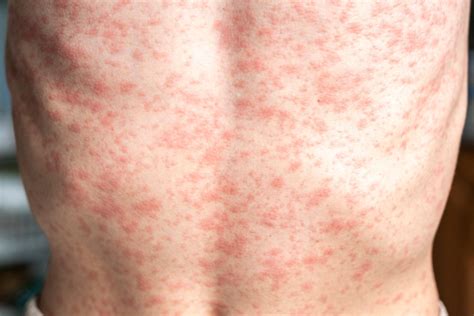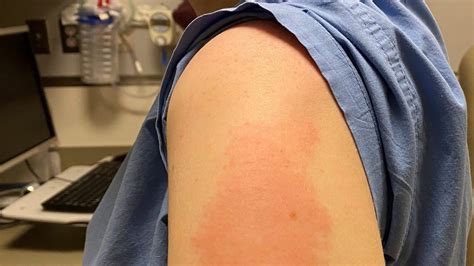Intro
Discover the causes, symptoms, and treatment options for the MMR vaccine rash. Learn how to identify and manage the common side effect of the measles, mumps, and rubella vaccination. Understand the differences between a normal vaccine reaction and a severe allergic reaction, and get expert advice on how to soothe and treat the rash effectively.
The MMR vaccine is a crucial immunization that protects against measles, mumps, and rubella. While it is generally a safe vaccine, some individuals may experience side effects, including a rash. In this article, we will delve into the causes, symptoms, and treatment of an MMR vaccine rash.

What is an MMR vaccine rash?
An MMR vaccine rash is a skin reaction that occurs in some individuals after receiving the MMR vaccine. The rash is usually mild and temporary, but in rare cases, it can be more severe. The rash is often accompanied by other symptoms such as fever, headache, and fatigue.
Causes of MMR Vaccine Rash
The exact cause of an MMR vaccine rash is not fully understood, but several factors are thought to contribute to its development. These include:
- Vaccine ingredients: The MMR vaccine contains weakened forms of the measles, mumps, and rubella viruses, as well as other ingredients such as gelatin, sorbitol, and sodium phosphate. Some individuals may be allergic to these ingredients, which can trigger a rash.
- Immune system reaction: The MMR vaccine works by stimulating the immune system to produce antibodies against the measles, mumps, and rubella viruses. In some cases, the immune system may overreact, leading to a rash.
- Genetic predisposition: Some individuals may be more prone to developing a rash after receiving the MMR vaccine due to their genetic makeup.
Symptoms of MMR Vaccine Rash
The symptoms of an MMR vaccine rash can vary in severity and may include:
- Redness and inflammation: The skin may become red, swollen, and warm to the touch.
- Itching and burning: The rash may be accompanied by itching and burning sensations.
- Small, flat spots: The rash may appear as small, flat spots or patches on the skin.
- Fever: A low-grade fever may occur, usually less than 102°F (39°C).
- Headache: Some individuals may experience a headache or fatigue.

Treatment of MMR Vaccine Rash
In most cases, an MMR vaccine rash will resolve on its own without treatment. However, there are some steps you can take to alleviate the symptoms:
- Apply cool compresses: A cool, wet compress can help reduce the itching and inflammation.
- Take antihistamines: Antihistamines such as diphenhydramine (Benadryl) can help relieve itching and reduce the risk of an allergic reaction.
- Use topical creams: Topical creams or ointments such as hydrocortisone can help reduce inflammation and itching.
- Take pain relievers: Pain relievers such as acetaminophen (Tylenol) or ibuprofen (Advil) can help alleviate headache and fever.
When to Seek Medical Attention
While an MMR vaccine rash is usually mild, there are some situations where you should seek medical attention:
- Severe rash: If the rash is severe, widespread, or accompanied by difficulty breathing, seek medical attention immediately.
- High fever: If the fever is high (over 104°F or 40°C) or lasts for more than 48 hours, seek medical attention.
- Signs of infection: If you experience signs of infection such as increased redness, swelling, or pus, seek medical attention.

Prevention of MMR Vaccine Rash
While it is not possible to completely prevent an MMR vaccine rash, there are some steps you can take to reduce the risk:
- Inform your healthcare provider: Inform your healthcare provider about any allergies or sensitivities you may have before receiving the MMR vaccine.
- Choose a reputable vaccine provider: Choose a reputable vaccine provider that follows proper vaccine storage and handling procedures.
- Follow post-vaccination instructions: Follow the post-vaccination instructions provided by your healthcare provider to reduce the risk of side effects.
Conclusion
An MMR vaccine rash is a common side effect of the MMR vaccine, but it is usually mild and temporary. By understanding the causes, symptoms, and treatment of an MMR vaccine rash, you can take steps to alleviate the symptoms and reduce the risk of complications. If you experience a severe rash or other concerning symptoms, seek medical attention immediately.
We hope this article has been informative and helpful. If you have any questions or concerns about the MMR vaccine or vaccine rash, please leave a comment below.
What is the MMR vaccine?
+The MMR vaccine is a vaccine that protects against measles, mumps, and rubella.
What are the common side effects of the MMR vaccine?
+Common side effects of the MMR vaccine include fever, headache, and fatigue.
How long does an MMR vaccine rash last?
+An MMR vaccine rash usually lasts for 2-5 days.
